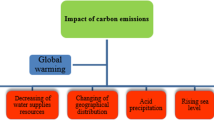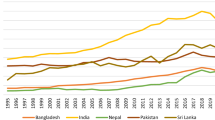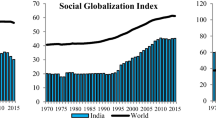Abstract
This study aims to examine the impact of industrial growth, agricultural value added, economic growth, and renewable energy consumption on environmental pollution in South and East Asian countries using panel ARDL approach over the period 1970–2020. Furthermore, the impact of institutional quality in this relationship is uniquely explored. Baseline model suggests that environmental damage is exacerbated by agricultural value added and industrial growth in the long run, but not in the short run. The relationship between economic growth and carbon emissions is an obvious inverted U-shaped link in the long run, but it is a U-shaped association in the short run. Renewable energy consumption has significant adverse effects on environmental pollution both in the short and long term. In the long run, institutional quality plays a stronger moderating role in the association between baseline regressors and environmental pollution. Also, institutional quality helps to expand the ability of industry and agriculture to improve environmental quality. Lastly, the threshold results reflect that the impact of regressors on environmental degradation is penetrating into the level of institutional quality. The strong progressive effects of agricultural and industrial growth on environmental degradation are more similar to the existing literature in the long term, but not in the short term. In addition, the long-term condensation effect of renewable energy on CO2 emissions and the enhancing effect of economic growth on CO2 emissions are relatively similar to existing literature. In contrast to weak institutional quality, strong institutions can improve the ability of agriculture and industry to reduce environmental damage.
Similar content being viewed by others
Data availability
The data supporting the outcomes of this study are freely available on the World Development Indicators page published by (World Bank, 2020), at https://databank.worldbank.org/source/world548 development-indicators. Data on renewable energy consumption is available at https://data.oecd.org/energy/renewable-energy.htm. Institutional quality index data is available at https://www.heritage.org/index/about. Ecological footprint data is available at https://www.footprintnetwork.org/resources/data/.
References
Abbasi KR, Shahbaz M, Zhang J, Irfan M, Alvarado R (2022a) Analyze the environmental sustainability factors of China: the role of fossil fuel energy and renewable energy. Renewable Energy 187:390–402
Abbasi KR, Adedoyin FF, Radulescu M, Hussain K, Salem S (2022b) The role of forest and agriculture towards environmental fortification: designing a sustainable policy framework for top forested countries. Environ Dev Sustain 24:8639–8666. https://doi.org/10.1007/s10668-021-01803-4
Adebayo TS (2022) Renewable energy consumption and environmental sustainability in Canada: does political stability make a difference? Environ Sci Pollut Res 29(40):61307–61322
Adedoyin FF, Bein MA, Gyamfi BA, Bekun FV (2021) Does agricultural development induce environmental pollution in E7? A myth or reality. Environ Sci Pollut Res 28:41869–41880
Adekoya OB, Ajayi GE, Suhrab M, Oliyide JA (2022) How critical are resource rents, agriculture, growth, and renewable energy to environmental degradation in the resource-rich African countries? The role of institutional quality. Energy Policy 164:112888
Ahmad N, Youjin L, Žiković S, Belyaeva Z (2023) The effects of technological innovation on sustainable development and environmental degradation: evidence from China. Technol Soc 72:102184
Alam MS, Duraisamy P, Siddik AB, Murshed M, Mahmood H, Palanisamy M, Kirikkaleli D (2023) The impacts of globalization, renewable energy, and agriculture on CO2 emissions in India: Contextual evidence using a novel composite carbon emission-related atmospheric quality index. Gondwana Res 119:384–401
Alharthi M, Hanif I, Alamoudi H (2022) Impact of environmental pollution on human health and financial status of households in MENA countries: future of using renewable energy to eliminate the environmental pollution. Renewable Energy 190:338–346
Alhassan H (2021) The effect of agricultural total factor productivity on environmental degradation in sub-Saharan Africa. Scientific African 12:e00740
Ali A, Radulescu M, Lorente DB, Hoang VNV (2022) An analysis of the impact of clean and non-clean energy consumption on economic growth and carbon emission: evidence from PIMC countries. Environ Sci Pollut Res 29(34):51442–51455
Ali A, Radulescu M, Balsalobre-Lorente D (2023) A dynamic relationship between renewable energy consumption, nonrenewable energy consumption, economic growth, and carbon dioxide emissions: Evidence from Asian emerging economies. Energy & Environment 0(0). https://doi.org/10.1177/0958305X231151684
Alqaralleh H, Hatemi-J A (2023) Revisiting the effects of renewable and non-renewable energy consumption on economic growth for eight countries: asymmetric panel quantile approach. Int J Energy Sect Manage. https://doi.org/10.1108/IJESM-10-2022-0022
Anwar A, Ahmad N, Madni GR (2020) Industrialization, freight transport and environmental quality: evidence from belt and road initiative economies. Environ Sci Pollut Res 27:7053–7070
Asian Development Bank (2022) Contribution of agriculture to climate change and low-emission agricultural development in Asia and the Pacific. https://www.adb.org/publications/contribution-of-agriculture-to-climate-change-and-low-emission-agricultural-development-in-asia-and-the-pacific
Balsalobre-Lorente D, Ibáñez-Luzón L, Usman M, Shahbaz M (2022) The environmental Kuznets curve, based on the economic complexity, and the pollution haven hypothesis in PIIGS countries. Renewable Energy 185:1441–1455
Baltagi BH, Feng Q, Kao C (2012) A lagrange multiplier test for cross-sectional dependence in a fixed effects panel data model. J Econ 170(1):164–177. https://doi.org/10.1016/j.jeconom.2012.04.004
Banga C, Deka A, Kilic H, Ozturen A, Ozdeser H (2022) The role of clean energy in the development of sustainable tourism: does renewable energy use help mitigate environmental pollution? A panel data analysis. Environ Sci Pollut Res 29(39):59363–59373
Barnaś K, Jeleński T, Nowak-Ocłoń M, Racoń-Leja K, Radziszewska-Zielina E, Szewczyk B, Śladowski G, Toś C, Varbanov PS (2023) Algorithm for the comprehensive thermal retrofit of housing stock aided by renewable energy supply: A sustainable case for Krakow. Energy 263:125774
Battisti S, Agarwal N, Brem A (2022) Creating new tech entrepreneurs with digital platforms: Meta-organizations for shared value in data-driven retail ecosystems. Technol Forecast Soc Chang 175:121392
Breusch TS, Pagan AR (1980) The Lagrange multiplier test and its applications to model specification in econometrics. Rev Econ Stud 47(1):239–253
Byaro M, Mafwolo G, Mayaya H (2022) Keeping an eye on environmental quality in Tanzania as trade, industrialization, income, and urbanization continue to grow. Environ Sci Pollut Res 29(39):59002–59012
Chakraborty SK, Mazzanti M (2020) Energy intensity and green energy innovation: Checking heterogeneous country effects in the OECD. Struct Chang Econ Dyn 52:328–343
Chen Y, Zhu Z, Cheng S (2022) Industrial agglomeration and haze pollution: evidence from China. Sci Total Environ 845:157392
Collins TW, Grineski SE, Nadybal SM (2022) A comparative approach for environmental justice analysis: explaining divergent societal distributions of particulate matter and ozone pollution across US neighborhoods. Ann Am Assoc Geogr 112(2):522–541
Dagar V, Khan MK, Alvarado R, Rehman A, Irfan M, Adekoya OB, Fahad S (2022) Impact of renewable energy consumption, financial development and natural resources on environmental degradation in OECD countries with dynamic panel data. Environ Sci Pollut Res 29(12):18202–18212
Eberhardt M, Teal F (2020) The magnitude of the task ahead: macro implications of heterogeneous technology. Review of Income and Wealth 66(2):334–360
EFSAS (2021) Environmental degradation in South Asia and China’s belt and road initiative. European foundation for South Asian Studies. https://www.efsas.org/publications/articles-by-efsas/environmentaldegradation-in-south-asia-and-china-bri/
Ehigiamusoe KU, Dogan E (2022) The role of interaction effect between renewable energy consumption and real income in carbon emissions: Evidence from low-income countries. Renew Sustain Energy Rev 154:111883
ESCAP (2020) East asia’s paths to industrialization and prosperity: lessons for india and other late comers in south asia. https://www.unescap.org/sites/default/d8files/knowledge-products/SSWA%20Development_Paper_20-03_Asian%20transformation.pdf
Fang W, Liu Z, Putra ARS (2022) Role of research and development in green economic growth through renewable energy development: empirical evidence from South Asia. Renewable Energy 194:1142–1152
FAO (2020) Emissions due to agriculture Global, regional and country trends 2000–2018. FAOSTAT Analytical Brief Series 18(2):2709–0078
Global Footprint Network (2023) Data and methodology. https://www.footprintnetwork.org/resources/data/
Grossman GM, Krueger AB (1995) Economic growth and the environment. Q J Econ 110(2):353–377
Gurbuz IB, Nesirov E, Ozkan G (2021) Does agricultural value-added induce environmental degradation? Evidence from Azerbaijan. Environ Sci Pollut Res 28:23099–23112
Gustavsson L, Haus S, Lundblad M, Lundström A, Ortiz CA, Sathre R, Wikberg PE (2017) Climate change effects of forestry and substitution of carbon-intensive materials and fossil fuels. Renew Sustain Energ Rev 67:612–624
Hafeez M, Yuan C, Shah WUH, Mahmood MT, Li X, Iqbal K (2020) Evaluating the relationship among agriculture, energy demand, finance and environmental degradation in one belt and one road economies. Carbon Management 11(2):139–154
Hansen BE (1999) Threshold effects in non-dynamic panels: estimation, testing, and inference. J Econ 93(2):345–368
Hashemizadeh A, Ju Y, Bamakan SMH, Le HP (2021) Renewable energy investment risk assessment in belt and road initiative countries under uncertainty conditions. Energy 214:118923
Hashmi SH, Fan H, Habib Y, Riaz A (2021) Non-linear relationship between urbanization paths and CO2 emissions: a case of South, South-East and East Asian economies. Urban Climate 37:100814
Hossain ME, Islam MS, Sujan MHK, Tuhin MMUJ, Bekun FV (2022) Towards a clean production by exploring the nexus between agricultural ecosystem and environmental degradation using novel dynamic ARDL simulations approach. Environ Sci Pollut Res 29(35):53768–53784
Justice S, Biggs S (2020) The spread of smaller engines and markets in machinery services in rural areas of South Asia. J Rural Stud 73:10–20
Kahia M, Ben Jebli M (2021) Industrial growth, clean energy generation, and pollution: evidence from top ten industrial countries. Environ Sci Pollut Res 28:68407–68416
Khan Z, Shahbaz M, Ahmad M, Rabbi F, Siqun Y (2019) Total retail goods consumption, industry structure, urban population growth and pollution intensity: an application of panel data analysis for China. Environ Sci Pollut Res 26:32224–32242
Lamb WF, Wiedmann T, Pongratz J, Andrew R, Crippa M, Olivier JG, Minx J (2021) A review of trends and drivers of greenhouse gas emissions by sector from 1990 to 2018. Environ Res Lett 16(7):073005
Leffel B, Tavasoli N, Liddle B, Henderson K, Kiernan S (2022) Metropolitan air pollution abatement and industrial growth: global urban panel analysis of PM10, PM25, NO2 and SO2. Environ Sociol 8(1):94–107
Li T, Li Y, An D, Han Y, Xu S, Lu Z, Crittenden J (2019) Mining of the association rules between industrialization level and air quality to inform high-quality development in China. J Environ Manage 246:564–574
Luo Y, Guo C, Ali A, Zhang J (2022) A dynamic analysis of the impact of FDI, on economic growth and carbon emission, evidence from China, India and Singapore. Environ Sci Pollut Res 29(54):82256–82270
Mesagan EP, Adewuyi TC, Olaoye O (2022) Corporate finance, industrial performance and environment in Africa: lessons for policy. Scientific African 16:e01207
Muhammad S, Pan Y, Agha MH, Umar M, Chen S (2022) Industrial structure, energy intensity and environmental efficiency across developed and developing economies: the intermediary role of primary, secondary and tertiary industry. Energy 247:123576
Mujtaba A, Jena PK, Bekun FV, Sahu PK (2022) Symmetric and asymmetric impact of economic growth, capital formation, renewable and non-renewable energy consumption on environment in OECD countries. Renew Sustain Energy Rev 160:112300
Nabuurs G-J, Mrabet R, Abu Hatab A, Bustamante M, Clark H, Havlik P, Towprayoon S (2022) Agriculture, Forestry and Other Land Uses (AFOLU). In Climate Change 2022 : Mitigation of Climate Change. Contribution of Working Group III to the Sixth Assessment Report of the Intergovernmental Panel on Climate Change, pp 747–860. https://doi.org/10.1017/9781009157926.009
Nielsen BB, Wechtler H, Zheng LG (2023) Disasters and international business: insights and recommendations from a systematic review. J World Bus 58(4):101458
Olabi AG, Obaideen K, Elsaid K, Wilberforce T, Sayed ET, Maghrabie HM, Abdelkareem MA (2022) Assessment of the pre-combustion carbon capture contribution into sustainable development goals SDGs using novel indicators. Renew Sustain Energy Rev 153:111710
Olanipekun IO, Olasehinde-Williams GO, Alao RO (2019) Agriculture and environmental degradation in Africa: the role of income. Sci Total Environ 692:60–67
Pesaran MH (2004) General diagnostic tests for cross section dependence in panels. University of Cambridge, Faculty of Economics, Cambridge Working Papers in Economics No. 0435.
Pesaran MH (2007) A simple panel unit root test in the presence of cross-section dependence. J Appl Economet 22(2):265–312
Pesaran MH, Smith R (1995) Estimating long-run relationships from dynamic heterogeneous panels. J Econ 68(1):79–113
Pesaran MH, Shin Y, Smith RP (1999) Pooled mean group estimation of dynamic heterogeneous panels. J Am Stat Assoc 94(446):621–634
Pesaran MH, Ullah A, Yamagata T (2008) A bias-adjusted LM test of error cross-section independence. Econ J 11(1):105–127
Pesaran MH, Yamagata T (2008) Testing slope homogeneity in large panels. J Econ 142(1):50–93
Qiao H, Zheng F, Jiang H, Dong K (2019) The greenhouse effect of the agriculture-economic growth-renewable energy nexus: evidence from G20 countries. Sci Total Environ 671:722–731
Rahman MM, Alam K (2022) Impact of industrialization and non-renewable energy on environmental pollution in Australia: do renewable energy and financial development play a mitigating role? Renewable Energy 195:203–213
Ridzuan NHAM, Marwan NF, Khalid N, Ali MH, Tseng ML (2020) Effects of agriculture, renewable energy, and economic growth on carbon dioxide emissions: evidence of the environmental Kuznets curve. Resour Conserv Recycl 160:104879
Salahodjaev R, Isaeva A (2021) Post-Soviet states and CO2 emissions: The role of foreign direct investment. Post-Communist Econ 34(7):1463–1377. https://doi.org/10.1080/14631377.2021.1965360
Sarkodie, SA, Ntiamoah EB, Li D (2019) Panel heterogeneous distribution analysis of trade and modernized agriculture on CO2 emissions: the role of renewable and fossil fuel energy consumption. Nat Res Forum 43(3):135–153
Shan T, Xia Y, Hu C, Zhang S, Zhang J, Xiao Y, Dan F (2022) Analysis of regional agricultural carbon emission efficiency and influencing factors: case study of Hubei Province in China. PLoS ONE 17(4):e0266172
Sharma GD, Shah MI, Shahzad U, Jain M, Chopra R (2021) Exploring the nexus between agriculture and greenhouse gas emissions in BIMSTEC region: the role of renewable energy and human capital as moderators. J Environ Manage 297:113316
Shi H, Chang M (2023) How does agricultural industrial structure upgrading affect agricultural carbon emissions? Threshold effects analysis for China. Environ Sci Pollut Res 30(18):52943–52957
Siddik AB, Khan S, Khan U, Yong L, Murshed M (2023) The role of renewable energy finance in achieving low-carbon growth: contextual evidence from leading renewable energy-investing countries. Energy 270:126864
Sumaira, Siddique HMA (2023) Industrialization, energy consumption, and environmental pollution: evidence from South Asia. Environ Sci Pollut Res 30(2):4094–4102
Syed QR, Bouri E (2022) Impact of economic policy uncertainty on CO2 emissions in the US: evidence from bootstrap ARDL approach. J Public Aff 22(3):e2595
Uddin MMM (2020) What are the dynamic links between agriculture and manufacturing growth and environmental degradation? Evidence from different panel income countries. Environ Sustain Indic 7:100041
Ullah S, Nadeem M, Ali K, Abbas Q (2022) Fossil fuel, industrial growth and inward FDI impact on CO2 emissions in Vietnam: testing the EKC hypothesis. Manag Environ Quality: an Int J 33(2):222–240
Ulucak R, Bilgili F (2018) A reinvestigation of EKC model by ecological footprint measurement for high, middle and low income countries. J Clean Prod 188:144–157
Usman M, Anwar S, Yaseen MR, Makhdum MSA, Kousar R, Jahanger A (2021) Unveiling the dynamic relationship between agriculture value addition, energy utilization, tourism and environmental degradation in South Asia. J Public Aff 22(4):e2712
Usman M, Balsalobre-Lorente D, Jahanger A, Ahmad P (2022) Pollution concern during globalization mode in financially resource-rich countries: do financial development, natural resources, and renewable energy consumption matter? Renewable Energy 183:90–102
Wang Q, Ali A, Chen Y, Xu X (2023) An empirical analysis of the impact of renewable and non-renewable energy consumption on economic growth and carbon dioxide emissions: evidence from seven Northeast Asian countries. Environ Sci Pollut Res 30:75041–75057. https://doi.org/10.1007/s11356-023-27583-0
Wang X, Feng Y (2021) The effects of national high-tech industrial development zones on economic development and environmental pollution in China during 2003–2018. Environ Sci Pollut Res 28:1097–1107
Warsame AA, Mohamed J, Mohamed AA (2023) The relationship between environmental degradation, agricultural crops, and livestock production in Somalia. Environ Sci Pollut Res 30(3):7825–7835
Wen J, Okolo CV, Ugwuoke IC, Kolani K (2022) Research on influencing factors of renewable energy, energy efficiency, on technological innovation. Does trade, investment and human capital development matter? Energy Policy 160:112718
Wu Q, Madni GR (2021) Environmental protection in selected one belt one road economies through institutional quality: prospering transportation and industrialization. PLoS ONE 16(1):e0240851
Xi B, Zhai P (2023) Economic growth, industrial structure upgrading and environmental pollution: Evidence from China. Kybernetes 52(2):518–553
Yang X, Khan I (2022) Dynamics among economic growth, urbanization, and environmental sustainability in IEA countries: the role of industry value-added. Environ Sci Pollut Res 29(3):4116–4127
Yurtkuran S (2021) The effect of agriculture, renewable energy production, and globalization on CO2 emissions in Turkey: a bootstrap ARDL approach. Renewable Energy 171:1236–1245
Zafar A, Ullah S, Majeed MT, Yasmeen R (2020) Environmental pollution in Asian economies: does the industrialisation matter? OPEC Energy Review 44(3):227–248
Zhang T, Yin J, Li Z, Jin Y, Ali A, Jiang B (2023) A dynamic relationship between renewable energy consumption, non-renewable energy consumption, economic growth and CO2 emissions: evidence from Asian emerging economies. Front Environ Sci 10:2721
Zhang X, Yao G, Vishwakarma S, Dalin C, Komarek AM, Kanter DR ... & Davidson EA (2021) Quantitative assessment of agricultural sustainability reveals divergent priorities among nations. One Earth 4(9): 1262–1277.
Zhao J, Zhang T, Ali A, Chen J, Ji H, Wang T (2023) An empirical investigation of the impact of renewable and non-renewable energy consumption and economic growth on climate change, evidence from emerging Asian countries. Front Environ Sci 10:1085372. https://doi.org/10.3389/fenvs.2022.1085372
Zhongwei H, Liu Y (2022) The role of eco-innovations, trade openness, and human capital in sustainable renewable energy consumption: evidence using CS-ARDL approach. Renewable Energy 201:131–140
Author information
Authors and Affiliations
Contributions
Y.S contributed to the conceptualization of the study, analysis, design, and conclusions; reviewed the manuscript; software data curation, editing, and literature search; and approved the final submission.
Corresponding author
Ethics declarations
Ethical approval
The study obtained ethical approval from Woosuk University, South Korea, 55338.
Consent to participate
Not applicable.
Consent for publication
The authors have provided consent to publish this work.
Competing interests
The author declares no competing interests.
Additional information
Responsible Editor: Eyup Dogan
Publisher's Note
Springer Nature remains neutral with regard to jurisdictional claims in published maps and institutional affiliations.
Appendix
Rights and permissions
Springer Nature or its licensor (e.g. a society or other partner) holds exclusive rights to this article under a publishing agreement with the author(s) or other rightsholder(s); author self-archiving of the accepted manuscript version of this article is solely governed by the terms of such publishing agreement and applicable law.
About this article
Cite this article
Sui, Y. Analyzing the impact of industrial growth and agricultural development on environmental degradation in South and East Asia. Environ Sci Pollut Res 30, 121090–121106 (2023). https://doi.org/10.1007/s11356-023-30766-4
Received:
Accepted:
Published:
Issue Date:
DOI: https://doi.org/10.1007/s11356-023-30766-4




